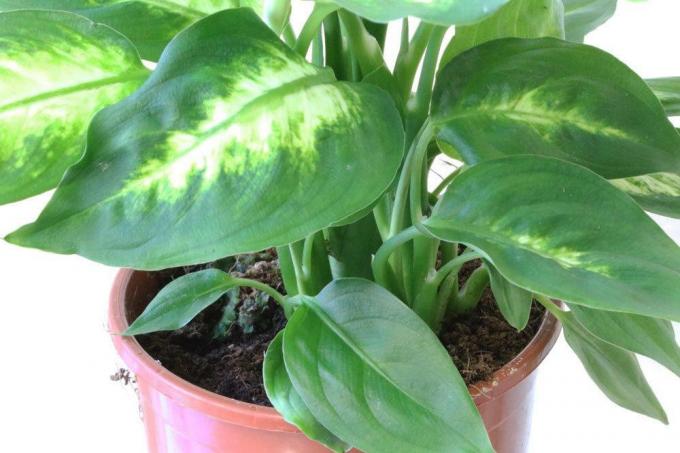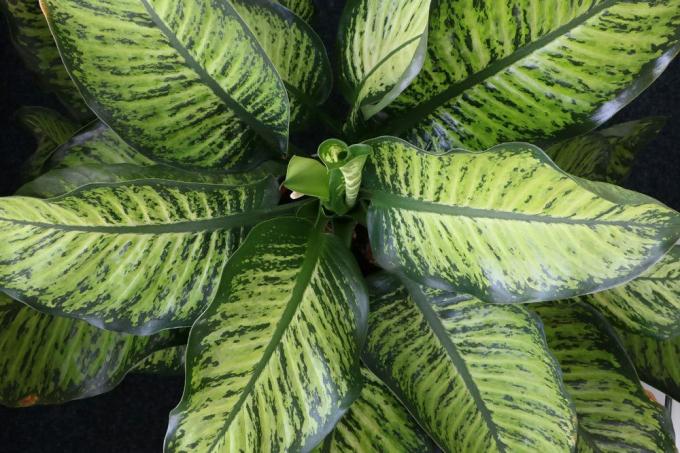
table of contents
- Toxicity
- Toxins
- Toxin absorption
- Risks to animals
- measures
- prevention
- children
- Pets
Dieffenbachia (also: Schweigrohr, Giftaron) originally comes from South America and is mainly native to Brazil. It is a popular houseplant because of its evergreen leaves with beautiful white or yellow patterns. Since it needs little sun and is otherwise very easy to care for, it is ideal for people who have little experience with plants. However, Dieffenbachia is poisonous and should therefore be treated with caution.
Toxicity
Which parts of the Dieffenbachia are poisonous?
There are numerous different types of Dieffenbachia that are difficult to distinguish from one another, but one What they have in common: All parts of the plant are poisonous, especially their stem, but also the petioles and leaves self. The poison of the plant is so strong that as little as 3 to 4 grams of the plant leaves have a deadly effect on adults. The two species Dieffenbachia seguine and Dieffenbachia picta are particularly poisonous.
Attention: Not only the parts of the plant themselves, but also irrigation water that has run off can contain toxins!
Toxins
What poisons does the plant contain?
Which toxins are contained in the Dieffenbachie has not yet been conclusively clarified. However, it is known that the following active ingredients are found in the parts of plants.
- Alkaloids
- Calcium oxalate
- cyanogenic glycosides
- proteolytic enzymes
- Saponins
- Sharp substances

In addition, the plants contain calcium oxalate needles about 0.25 millimeters in size, through which toxic substances such as oxalic acid flow. When the plant is touched, so-called shooting cells open, through which the calcium oxalate needles and other toxins are ejected.
Toxin absorption
What are the risks for people, especially children / babies, if they are touched or swallowed?
Touching the sap can cause skin irritation and blistering. If the juice gets into the eyes, it causes severe tearing, eyelid cramps and can burn the conjunctiva. There is a risk of injuries and permanent damage to the cornea.
When parts of plants are swallowed, typical symptoms of poisoning occur: reddened and burning mucous membranes, intensified Salivation, swallowing and speaking problems, swollen tongue, irregular heartbeat, nausea, vomiting, diarrhea, drowsiness and Signs of paralysis
Tip: When repotting, dusting, or pruning the plant's leaves, it is best to wear gloves, long sleeves, and safety glasses. The latter protects you from accidentally getting the poison into your eyes!
Risks to animals
What are the risks for animals, e.g. B. typical pets like cats, dogs, etc?
The poison of Dieffenbachia is extremely dangerous for animals such as dogs, cats, rabbits, guinea pigs, hamsters and birds. Poisoned animals show symptoms such as severe irritation of the mouth, throat, stomach and intestines.
They have difficulty swallowing, have difficulty breathing, and lose their voice. Bloody diarrhea occurs in some pets. Gastrointestinal problems are the exception, however, as the animals drain the plant immediately after the first symptoms appear. The symptoms usually take a few days to subside. In some animals, however, ingesting parts of the plant leads to sterility. In the worst case scenario, Dieffenbachia poisoning is fatal for pets.

Note: Especially if you cannot always keep an eye on the animal and be in the same room with the poisonous plant, always keep in mind the danger of poisoning. In the event of poisoning, act quickly and, if symptoms occur, consult a veterinarian as soon as possible.
measures
How should one react when touched or consumed?
First, you should carefully remove any plant debris that may still be in your mouth. Spit out any fibers and rinse your mouth thoroughly afterwards. You can drink, but avoid milk because it can help the stomach to absorb toxins. Some experts recommend taking charcoal powder or charcoal tablets, which are supposed to bind the toxins in the stomach. If in doubt, you should call the Poison Control Center and obtain further first aid instructions.
As soon as health complaints such as the above symptoms appear, it is imperative that you consult a doctor. If your child has touched or swallowed parts of the dieffenbachia, take these first aid measures and watch them closely. If in doubt, contact your pediatrician directly!
Note: If possible, these measures also apply to the poisoning of animals. For further first aid, please bring your animal to the vet or call the local animal emergency number. Please note that due to their lower body weight, animals are exposed to a greater risk of poisoning even if they consume a small amount of Dieffenbachia.

prevention
What precautionary measures are recommended?
children
Tip: To avoid accidents, families with small children or pets should avoid the Dieffenbachia as a houseplant and prefer alternatives.
If you still want to have a plant of this type at home, you should take the following precautionary measures.
- only place the plant in lockable rooms that children cannot enter alone
- place the plant as high as possible, for example on a high shelf or in a hanging basket under the ceiling
- tell older children that Dieffenbachia is poisonous and explain what can happen if they touch the leaves or other parts of the plant
Pets
Since pets unfortunately often do not understand prohibitions and certainly no explanations, you should refrain from cultivating the plant here. Alternatively, you can only set up the Dieffenbachia in rooms that dogs, cats or birds are sure not to get into. And watch out for the irrigation water! Some animals drink it and in this way ingest the toxins it contains.
Sources:
http://gizbonn.de/fileadmin/user_upload/daten/Ratgeber_Vergiftungsunfaelle_GIZ_BN.pdf
http://www.gifte.de/Giftpflanzen/dieffenbachia_seguine.htm
https://www.animal-learn.de/tipps-rund-um-den-hund-kat/115-giftpflanzen.html
https://de.wikipedia.org/wiki/Dieffenbachia
https://www.netdoktor.de/giftpilze-giftpflanzen/dieffenbachie-12435.html



